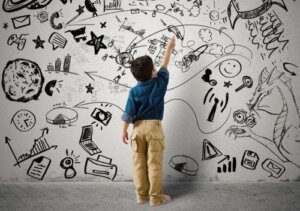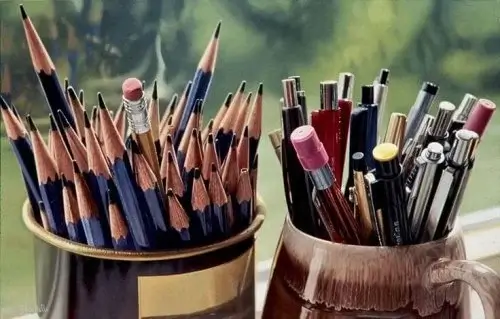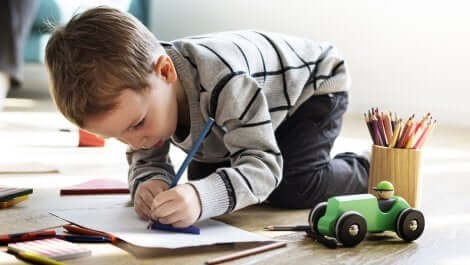The Benefits of Drawing for Children


Reviewed and approved by the psychologist María Alejandra Castro Arbeláez
Painting and drawing are two of the oldest expressions of humanity that account for the daily activities of our ancestors. Currently, several studies have shown the benefits of drawing in children. Therefore, this spontaneous artistic activity represents a milestone in your child’s development
In this way, specialists indicate that it’s ideal for each child to have some contact with this form of manifestation and expression from an early age, whether they’re simple doodles or incipiently recognizable forms.
And what are you waiting for your child to draw? Remember that the more they draw, paint, and color, the better their development will be. The benefits of drawing in children are many and can be expressed in various areas such as motor, intellectual, emotional areas, among others.
Drawing in children
This playful activity has the invaluable capacity to enhance the abilities of minors while helping to develop their personality, as well as facilitating the projection of your child’s inner world while putting complex neuropsychic functions into play.
Experts maintain that painting improves fine motor skills and writing in children, who through this pastime, also develop their creativity and increase their self-confidence. Another of the great benefits of drawing in children is the expression of feelings, emotions, and sensations.
Motivate your child to paint because this hobby not only amuses and enhances both their fantasy and their creative tendencies but also improves aspects of their development. On a physical level, they perfect the manual skills that allow them to handle small objects and sharpen their spatial notion.
On an emotional level, drawing in children produces great satisfaction and reinforces their self-esteem while it makes it possible to channel their state of mind in a positive way, even if they don’t know or can’t externalize it orally.
Drawing in children: Suitable materials
There are various techniques and materials for any child to fully enjoy the enriching experience of children’s drawing and art, as it’s not just about using conventional elements such as pencils and colors.
As much as possible, it’s best to resort to objects that offer different textures, such as paint mixed with flour or salt, chalk with water, gelatin, or sugar are excellent tools for making works of art.

Important! To prevent all kinds of mishaps, provide the child with the most appropriate utensils and materials for their age. Offer them a piece of paper or a blackboard to paint on, preferably a light color so that they can distinguish their lines.
Also, avoid giving them pages or notebooks, but rather large papers that allow them to make wide turns with their arms. Other good ideas are to place a washable surface on the floor or buy them a big blackboard like the one at school if they like to paint standing up and have more freedom of movement.
Regarding paints, it’s best to buy finger paints, thick markers, short and thick crayons, printing sponges, and “sleeved” chalk, which are easy to grasp. Always make sure to choose non-toxic, washable, and child-friendly materials.
The benefits of drawing in children
Promoting the benefits of drawing in children is important because it implies providing them with a tool that increases their ability to function socially. Painting also stimulates children’s creativity and sensitivity.
In addition, other benefits of drawing are the reduction of anxiety, fears, and expectations, the expression of concerns and emotions, and the development of artistic tastes and profiles.
- Encourage communication. Art humanizes us, helps us communicate in a different and personal language. This is a great benefit, especially for children who are shy, autistic, or have certain disabilities. Therefore, it’s an excellent means of communication and expression where verbal skills do not interfere.
- Improves motor skills. Although it may seem like an exaggeration, holding a pencil or handling a paintbrush helps regulate hand movements and stimulate brain connections. That’s why we talk about the benefits that drawing brings in regard to fine motor skills. For this same reason, it’s even said that painting prepares children to easily perform some tasks as important as writing.

- It helps develop their individuality and increases self-esteem. It’s a noncompetitive and relaxed environment in which little ones enjoy their personal achievements. That’s why drawing is of great importance for those children with problems of co-dependency and trauma. When a child learns to paint, they feel good about themselves and, not being able to be labeled as good and bad or pigeonholed as winners or losers, they don’t feel exposed to feelings of frustration.
- Relax, serene, and calm. Through painting, little ones can vent their feelings, materialize their emotions on paper. Therefore, each feeling will be expressed through different colors and shapes, through a pleasant process.
- They learn to appreciate art. If a child gets used to this visual language, they’ll be able to interpret the work of others as well as arouse the desire to learn more about art in general. Practicing, understanding, and talking about art will allow the child to be the recipient of this type of communication.
- Drawing adds fun. Through this form of expression, children create new worlds, discover how colors are formed, develop a space where everything is possible. Through drawing, children laugh, socialize, learn, appreciate nature, and are passionate about something healthy.
- It serves as therapy. Painting is an individual activity where a world of its own reigns, as the stimulation of their creative part allows positive isolation from reality, producing mental rest that reduces stress and produces feelings of happiness and relaxation. For this reason, experts on the subject recommend this activity for children with aggressiveness and nervousness problems, as painting is used successfully as a therapy for syndromes such as autism.
- Promotes attention, concentration, and healing. Anyone who spends several hours painting reaches a very marked state of concentration where they erase the environment and lose track of time while forgetting fatigue or physical pain. This is what is known as the state of Alpha concentration, where one part of the brain is conscious and the other brings up the unconscious.
- Provides mental health. Painting distracts children from their problems, turning anguish into something beautiful, allowing feelings to be identified and expressive capacity to be increased. This is beneficial and cathartic for nervous children or those with mental problems, or for those who are going through an emotional imbalance or sentimental breakdown.
- It stimulates brain activity. Drawing stimulates both hemispheres of the brain: The left involves the logical-rational side while the right exploits our creativity and emotions. In this way, this activity combats diseases such as Alzheimer’s while strengthening the imagination.
Have you realized all the benefits of drawing in children? What are you waiting for to give your child colored pencils and a piece of paper? So, whether it’s for health, recreation, or a personal goal, let’s draw!
Painting and drawing are two of the oldest expressions of humanity that account for the daily activities of our ancestors. Currently, several studies have shown the benefits of drawing in children. Therefore, this spontaneous artistic activity represents a milestone in your child’s development
In this way, specialists indicate that it’s ideal for each child to have some contact with this form of manifestation and expression from an early age, whether they’re simple doodles or incipiently recognizable forms.
And what are you waiting for your child to draw? Remember that the more they draw, paint, and color, the better their development will be. The benefits of drawing in children are many and can be expressed in various areas such as motor, intellectual, emotional areas, among others.
Drawing in children
This playful activity has the invaluable capacity to enhance the abilities of minors while helping to develop their personality, as well as facilitating the projection of your child’s inner world while putting complex neuropsychic functions into play.
Experts maintain that painting improves fine motor skills and writing in children, who through this pastime, also develop their creativity and increase their self-confidence. Another of the great benefits of drawing in children is the expression of feelings, emotions, and sensations.
Motivate your child to paint because this hobby not only amuses and enhances both their fantasy and their creative tendencies but also improves aspects of their development. On a physical level, they perfect the manual skills that allow them to handle small objects and sharpen their spatial notion.
On an emotional level, drawing in children produces great satisfaction and reinforces their self-esteem while it makes it possible to channel their state of mind in a positive way, even if they don’t know or can’t externalize it orally.
Drawing in children: Suitable materials
There are various techniques and materials for any child to fully enjoy the enriching experience of children’s drawing and art, as it’s not just about using conventional elements such as pencils and colors.
As much as possible, it’s best to resort to objects that offer different textures, such as paint mixed with flour or salt, chalk with water, gelatin, or sugar are excellent tools for making works of art.

Important! To prevent all kinds of mishaps, provide the child with the most appropriate utensils and materials for their age. Offer them a piece of paper or a blackboard to paint on, preferably a light color so that they can distinguish their lines.
Also, avoid giving them pages or notebooks, but rather large papers that allow them to make wide turns with their arms. Other good ideas are to place a washable surface on the floor or buy them a big blackboard like the one at school if they like to paint standing up and have more freedom of movement.
Regarding paints, it’s best to buy finger paints, thick markers, short and thick crayons, printing sponges, and “sleeved” chalk, which are easy to grasp. Always make sure to choose non-toxic, washable, and child-friendly materials.
The benefits of drawing in children
Promoting the benefits of drawing in children is important because it implies providing them with a tool that increases their ability to function socially. Painting also stimulates children’s creativity and sensitivity.
In addition, other benefits of drawing are the reduction of anxiety, fears, and expectations, the expression of concerns and emotions, and the development of artistic tastes and profiles.
- Encourage communication. Art humanizes us, helps us communicate in a different and personal language. This is a great benefit, especially for children who are shy, autistic, or have certain disabilities. Therefore, it’s an excellent means of communication and expression where verbal skills do not interfere.
- Improves motor skills. Although it may seem like an exaggeration, holding a pencil or handling a paintbrush helps regulate hand movements and stimulate brain connections. That’s why we talk about the benefits that drawing brings in regard to fine motor skills. For this same reason, it’s even said that painting prepares children to easily perform some tasks as important as writing.

- It helps develop their individuality and increases self-esteem. It’s a noncompetitive and relaxed environment in which little ones enjoy their personal achievements. That’s why drawing is of great importance for those children with problems of co-dependency and trauma. When a child learns to paint, they feel good about themselves and, not being able to be labeled as good and bad or pigeonholed as winners or losers, they don’t feel exposed to feelings of frustration.
- Relax, serene, and calm. Through painting, little ones can vent their feelings, materialize their emotions on paper. Therefore, each feeling will be expressed through different colors and shapes, through a pleasant process.
- They learn to appreciate art. If a child gets used to this visual language, they’ll be able to interpret the work of others as well as arouse the desire to learn more about art in general. Practicing, understanding, and talking about art will allow the child to be the recipient of this type of communication.
- Drawing adds fun. Through this form of expression, children create new worlds, discover how colors are formed, develop a space where everything is possible. Through drawing, children laugh, socialize, learn, appreciate nature, and are passionate about something healthy.
- It serves as therapy. Painting is an individual activity where a world of its own reigns, as the stimulation of their creative part allows positive isolation from reality, producing mental rest that reduces stress and produces feelings of happiness and relaxation. For this reason, experts on the subject recommend this activity for children with aggressiveness and nervousness problems, as painting is used successfully as a therapy for syndromes such as autism.
- Promotes attention, concentration, and healing. Anyone who spends several hours painting reaches a very marked state of concentration where they erase the environment and lose track of time while forgetting fatigue or physical pain. This is what is known as the state of Alpha concentration, where one part of the brain is conscious and the other brings up the unconscious.
- Provides mental health. Painting distracts children from their problems, turning anguish into something beautiful, allowing feelings to be identified and expressive capacity to be increased. This is beneficial and cathartic for nervous children or those with mental problems, or for those who are going through an emotional imbalance or sentimental breakdown.
- It stimulates brain activity. Drawing stimulates both hemispheres of the brain: The left involves the logical-rational side while the right exploits our creativity and emotions. In this way, this activity combats diseases such as Alzheimer’s while strengthening the imagination.
Have you realized all the benefits of drawing in children? What are you waiting for to give your child colored pencils and a piece of paper? So, whether it’s for health, recreation, or a personal goal, let’s draw!
All cited sources were thoroughly reviewed by our team to ensure their quality, reliability, currency, and validity. The bibliography of this article was considered reliable and of academic or scientific accuracy.
- Acaso, M. (2000). Simbolización, expresión y creatividad: tres propuestas sobre la necesidad de desarrollar la expresión plástica infantil. Arte, individuo y sociedad, (12), 41. https://revistas.ucm.es/index.php/ARIS/article/download/ARIS0000110041A/5919
- Cándano, S. (2013). La pintura beneficiosa para el desarrollo de los niños. http://www.ampaikasbide.com/downloads/pintura/Desarrollo%20y%20aprendizaje.pdf
- Cardozo, S. Y. C., Cardozo, E. C., & Acevedo, E. A. P. (2018). El arte en un acto sensible: El niño en procesos creativos. Calle 14 revista de investigación en el campo del arte, 13(23), 186-196. https://www.redalyc.org/journal/2790/279054997012/279054997012.pdf
- Cordera, M., Bertolez, A., Monesterolo, L., & Herrera, M. El dibujo infantil como expresión de desarrollo saludable.
- Goodnow, J. (1979). El dibujo infantil (Vol. 8). Ediciones Morata.
- Lowenfeld, V. & Brittain, W. L. (1980). Desarrollo de la capacidad creadora (2a Ed.). Buenos Aires: Kapelusz.
- Medina-Sánchez, N., Velázquez Tejeda, M. E., Alhuay Quispe, J., & Aguirre Chávez, F. (2017). La creatividad en los niños de prescolar, un reto de la educación contemporánea. https://repositorio.usil.edu.pe/items/931fe65d-74c5-46b2-afae-21f412d0f982
- Mujica Jiménez, A. S. (2012). Estrategias para estimular el dibujo en los estudiantes de educación inicial. Revista de investigación, 36(77), 147-164. http://ve.scielo.org/scielo.php?pid=S1010-29142012000300009&script=sci_arttext
- Muños-Hidalgo, M. D. (2014). El dibujo infantil: La etapa preesquemática. http://tauja.ujaen.es/bitstream/10953.1/796/4/TFG_MuñozHidalgo%2cMar%C3%ADaDolores.pdf
- Tello, P. M., & Cubero, I. O. (2003). ‘Informalismo y Arte Infantil Informalismo y Arte Infantil. Arte, individuo y sociedad, 15, 83-114. https://revistas.ucm.es/index.php/ARIS/article/download/ARIS0303110083B/5835/0
- Rojas, E. M. P. (2012). La evolución del dibujo infantil. Una mirada desde el contexto sociocultural merideño. Educere, 16(53), 157-170. https://www.redalyc.org/pdf/356/35623538016.pdf
- Sampedro-Lampon, M. D. P. (2018). Expresionismo abstracto de Pollock como modelo de lenguaje plástico para los niños de 5 años (Bachelor’s thesis). https://reunir.unir.net/bitstream/handle/123456789/7649/SAMPEDRO%20LAMP%c3%93N%2c%20MARIA%20DEL%20PILAR.pdf?sequence=1&isAllowed=y
- Viadel, R. M. (1988). El dibujo infantil: tendencias y problemas en la investigación sobre la expresión plástica de los escolares. Arte, individuo y sociedad, (1), 5. https://scholar.google.com/scholar_url?url=https://revistas.ucm.es/index.php/ARIS/article/download/ARIS8888110005A/6070&hl=es&sa=T&oi=gsb-ggp&ct=res&cd=0&d=18242260912850913863&ei=XkIoYtnPLavGsQLO2azwCQ&scisig=AAGBfm1Fyof5DmOifhAebLFZ8m9hJCjZDg
- Zapata Gutiérrez, M. M. (2019). Tras las huellas del arte infantil. Revista de la Escuela de Ciencias de la Educación, 2(14), 71-80. http://www.scielo.org.ar/scielo.php?script=sci_arttext&pid=S2362-33492019000200008
This text is provided for informational purposes only and does not replace consultation with a professional. If in doubt, consult your specialist.








